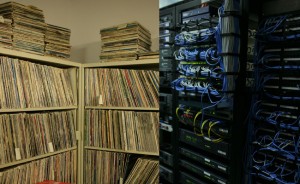Warning: Use of undefined constant wpurl - assumed 'wpurl' (this will throw an Error in a future version of PHP) in /home/y9gq09f5yym1/public_html/wp-content/plugins/add-to-facebook-plugin/addtofacebook.php on line 50
Today’s New York Times features a front-page story about the evolution of non-commercial radio, “College Radio Heads: Off the Dial.” It is a very encouraging article about how many members of the Intercollegiate Broadcasting System, the organization that guides the building of stations, are now online and reaching new audiences previously unavailable to them as low power FMs. Besides allowing many programs to continue, it also creates a possibility for students at schools where the FM signal is dedicated to a more restrictive (and profitable) format.
I don’t begrudge the extended life of Fredonia’s WDVL and WFUV’s Alternate Side, considering the demise of WRVU, KUSF and KTRU, and practical faculty advisors who warn their students (at Drexel’s WKDU) “You don’t want to end up another Vanderbilt.” Popularity or interaction from fans on the net should not be the goal of these stations. That’s for commercial media. At least the article mentions some real niche programming, like a cupcake or yoga show, that represent the old progressive FM mentality. Ironically, the article omitted that some of the most radical stations, WXYC, Chapel Hill; WFMU, Jersey City and KFJC, Los Altos Hills were some of the first radio stations to stream live online in the early 90s. Internet broadcasting in itself was an idea that developed in a non-commercial, experimental environment.
I believe “another Vanderbilt,” KUSF or KTRU are exactly what we need. The success of college broadcasting should not be having found a pop group like 3OH3 for Top 40 or having “clusters of listeners” around the world. It should be a creative or intellectual success enabled by technology, like WFMU’s annual broadcast of the Prima Vera Festival or the Free Music Archive — using the net to proliferate ideas that would not be exposed elsewhere. People have to be willing to take chances, and even 3OH3’s story shows that.
The charter of non-commercial radio has not changed even if the mode of communication has. The article doesn’t mention that Fordham and other schools maintain highly profitable “non-comm”/triple a stations on fm dials while shunting more progressive music onto the net stations. Does Southern California need another FM station to play Tom Petty or should the students of Cal State Northridge have a better learning opportunity? There are many gradations and arguments on all sides and that’s how it should stay.
As a longtime observer and participant in the college radio ecosystem, I feel its greatest value is as a training ground for ALL new ideas, not just music-related. College radio is about opportunity for all. As John Platt from WFUV said, the multimedia content provider model is where we are headed, so the growth of online is also organic and technology-based, not just economically or aesthetically-driven. The founders of Google are big fans of Burning Man, a boundary-free arts festival. College radio is a similar forum that should not be inhibited.
Survivability is a concern. Who would have thought that the ultra-radical WKDU would become part of a school program on how to run a record company? It’s happening everywhere, in all walks of life. We can only hope that the proliferation of progressive ideas continues below 92 or on a .org.
Occupy college radio (.org or FM)!
